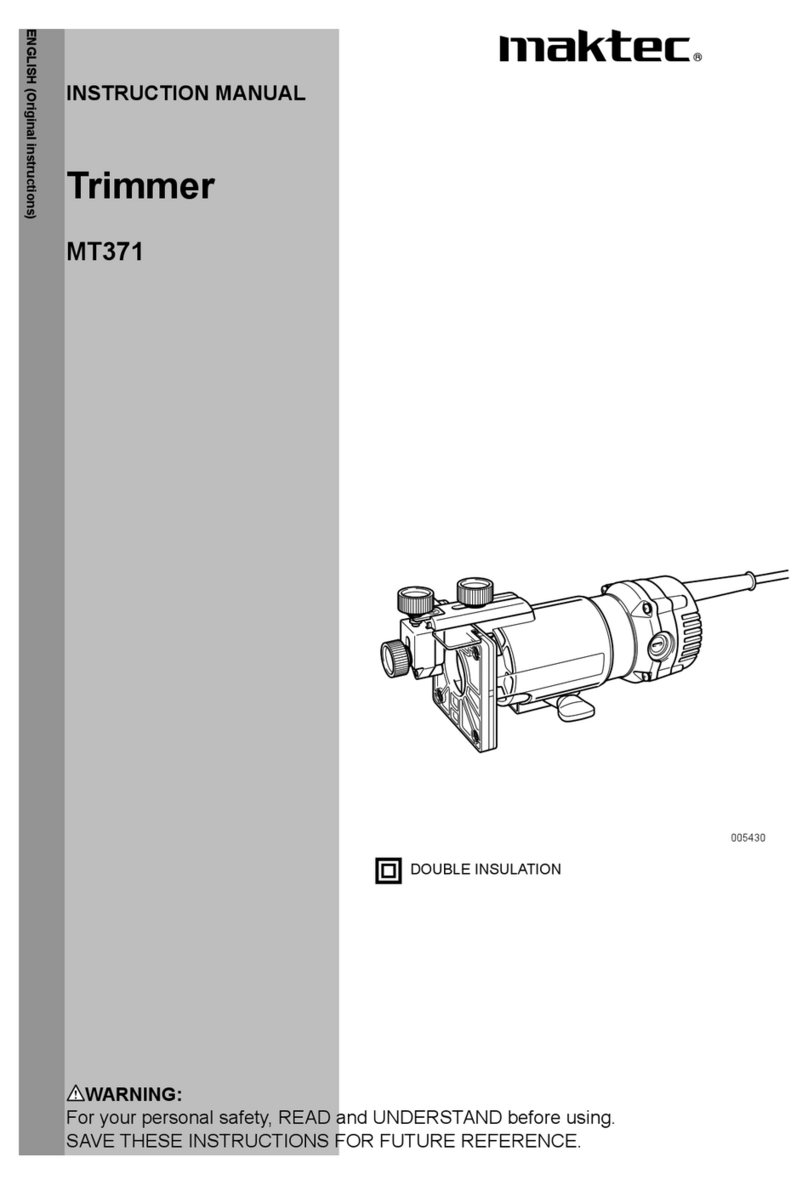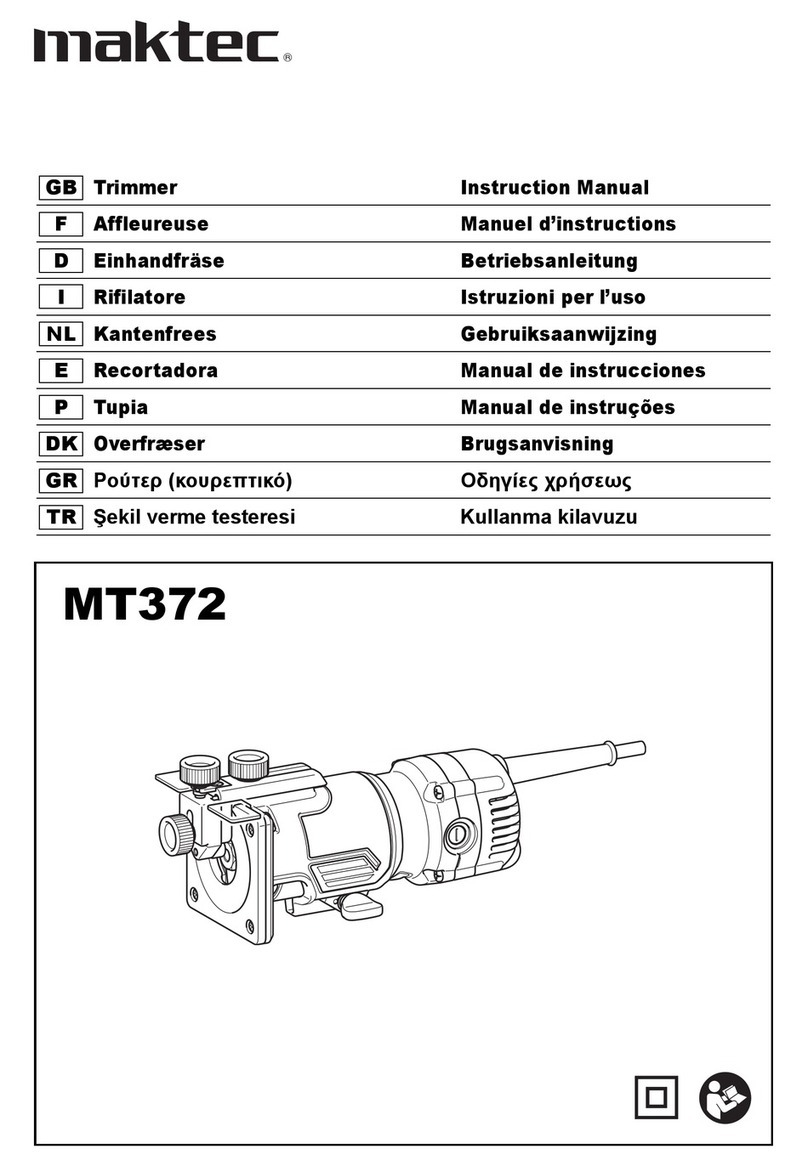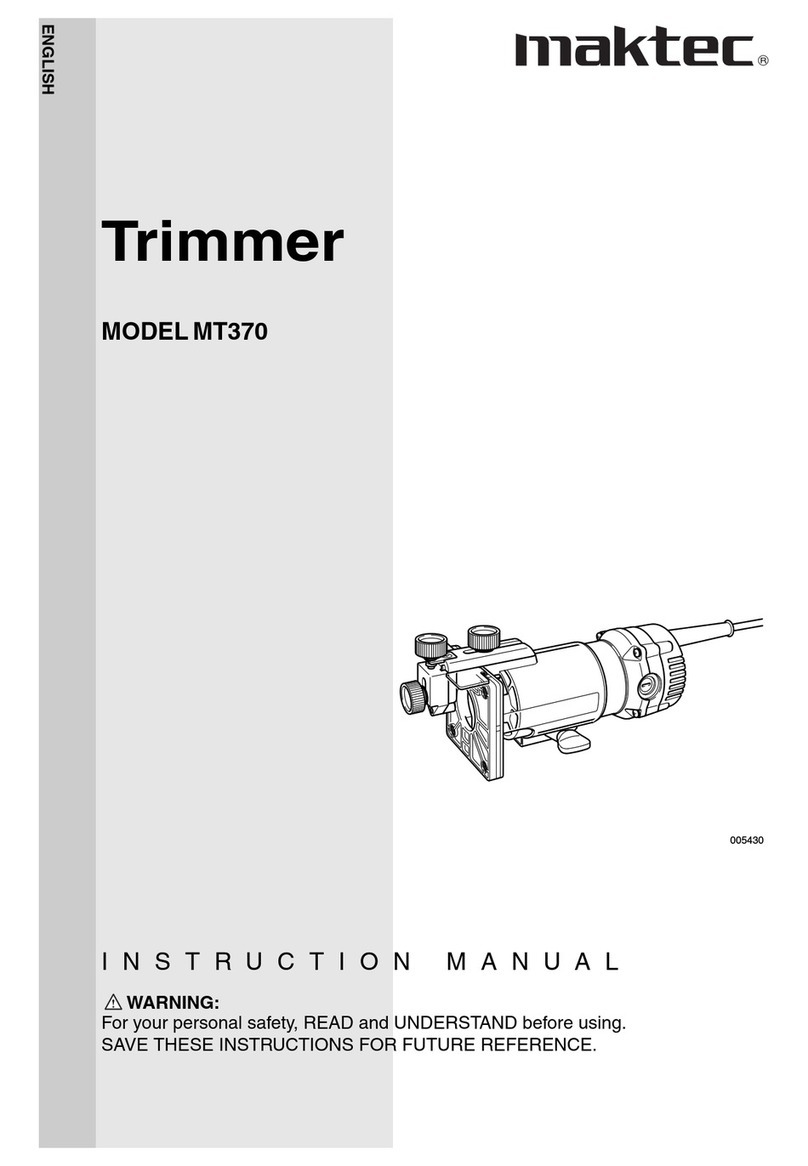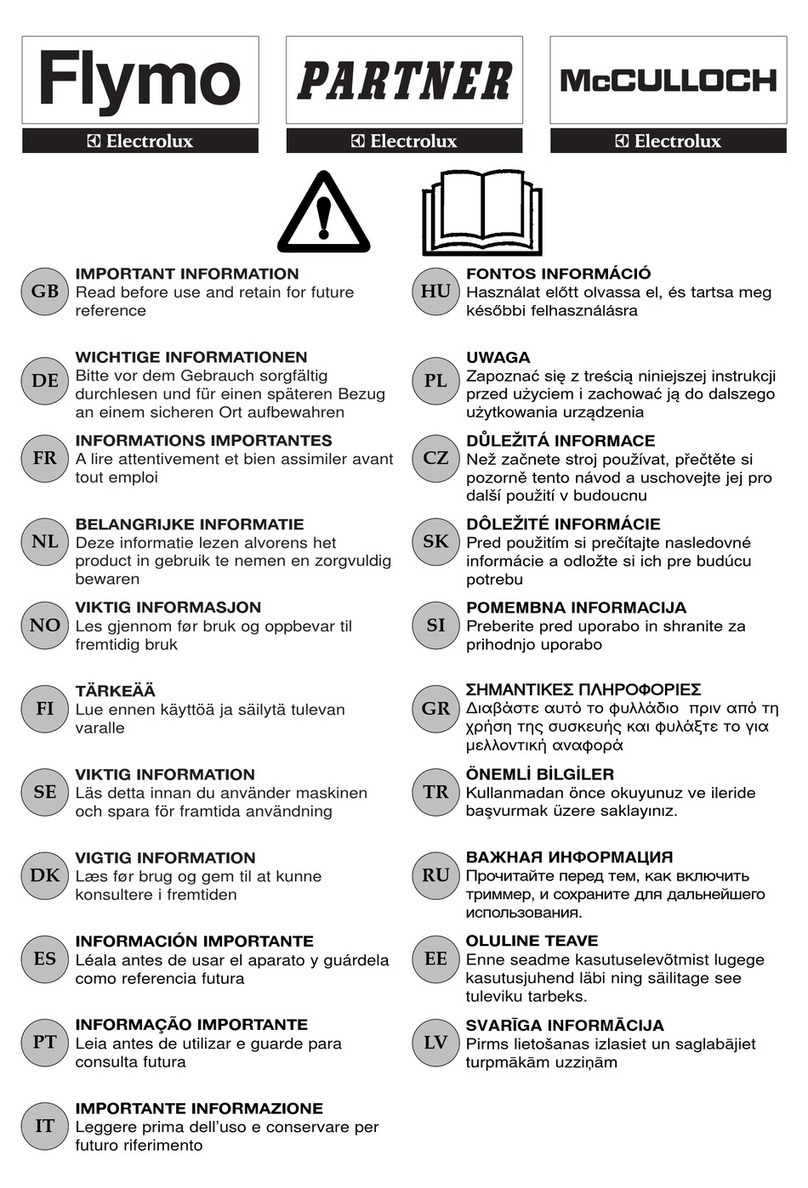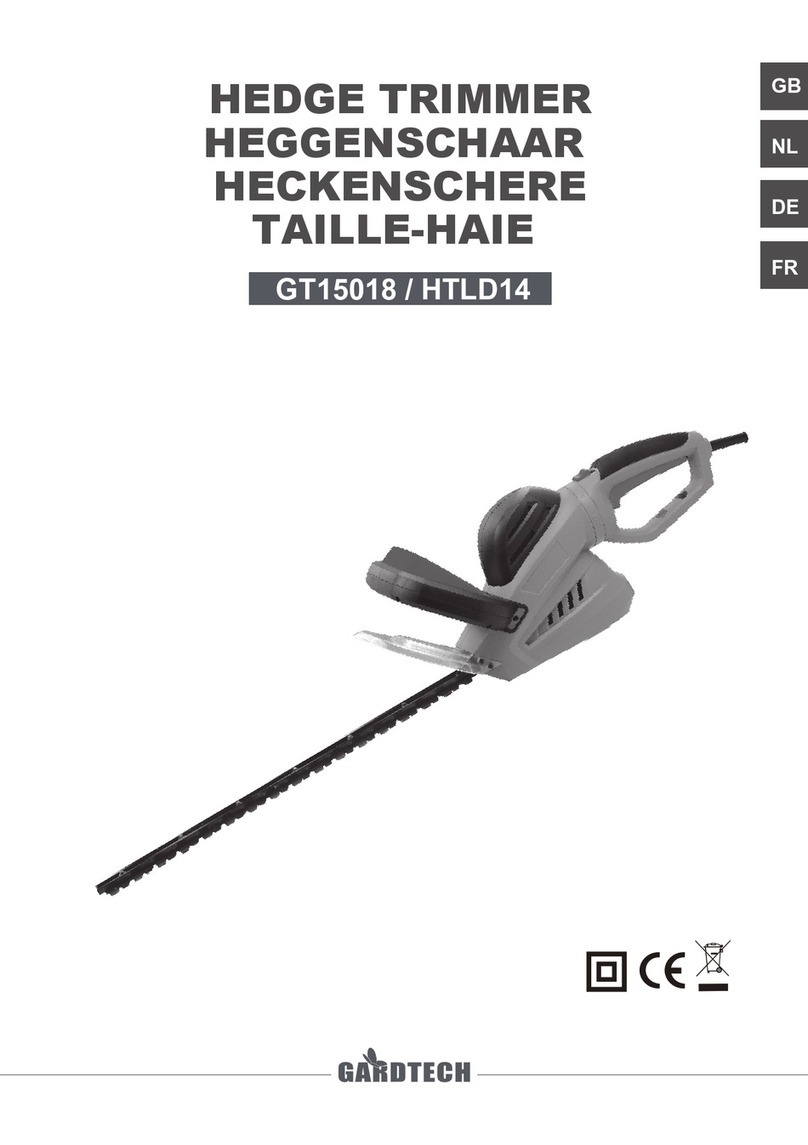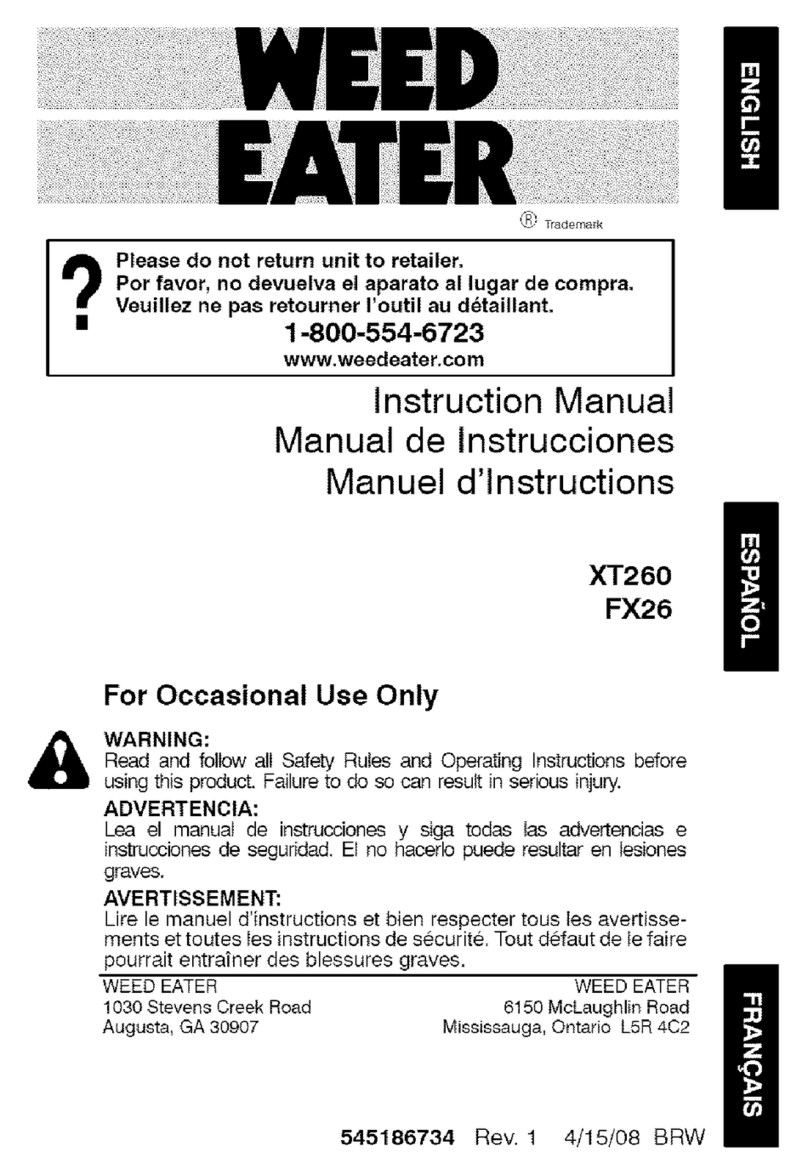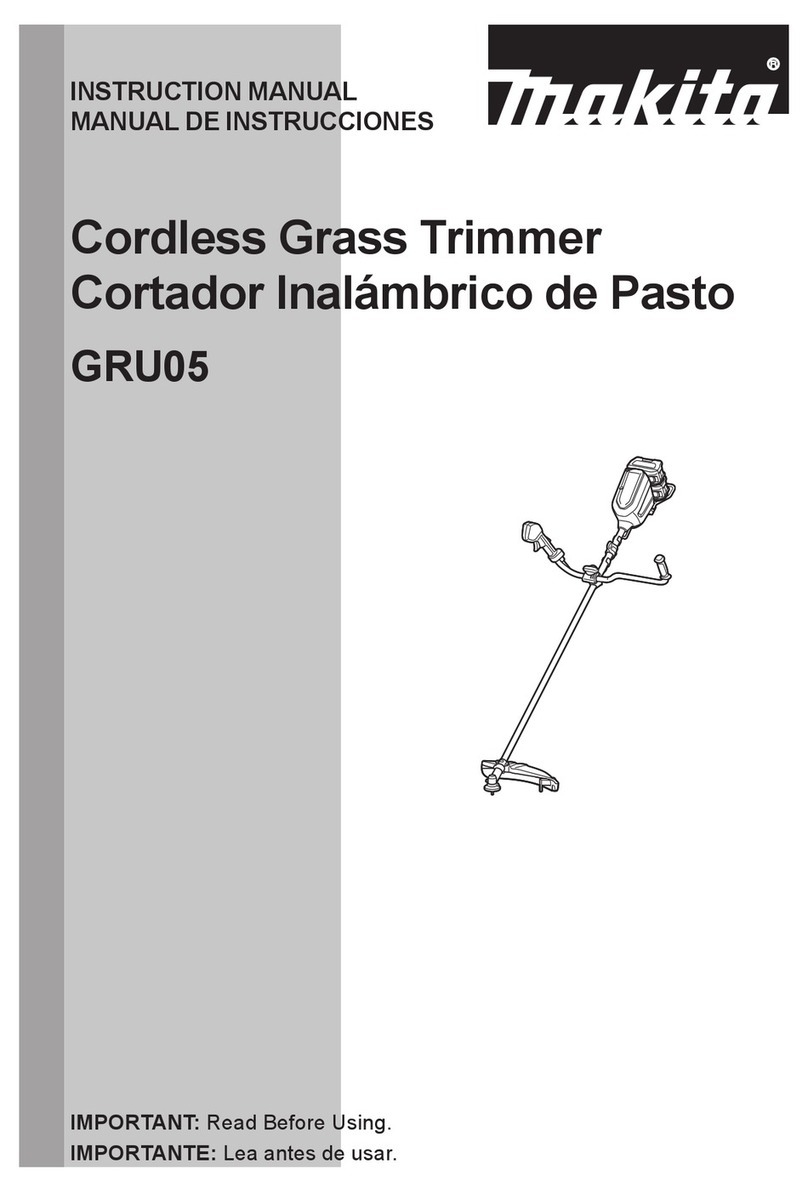Maktec MT372 User manual

GB Trimmer Instruction manual
ID Mesin Profil Petunjuk penggunaan
Máy Đánh Cạnh Cầm Tay Hoạt Động
Bằng Động CơĐiện
VI Tài liệu hướng dẫn
TH เครื่องฉลุลายไมไฟฟาคูมือการใชงาน
MT372

2
1013205 2005432
3013207 4013217
5001984 6001985
7013208 8013215
1
2
3
4
5
6
7
8
9
10
11
12 12
10
12
10
9
13
14
15
16
17
19
18

3
9013209 10 005435
11 013210 12 001990
13 013211 14 013212
15 001993 16 001994
20
21
22
22
23
1
24
9
25
26
27
13
28
14
13
28
1
A
28
27
13
29
26
28
27
13
29
26

4
17 013213 18 013214
19 001998 20 001145
21 013216 22 005116
23 005117 24 005118
30
29
13
9
23
31
32
33
20
R

5
25 005120 26 005121
27 005125 28 005126
29 005129 30 005130
31 005131 32 005132

6
33 005133 34 005134
35 005135

7
ENGLISH
Explanation of general view
SPECIFICATIONS
• Due to our continuing program of research and development, the specifications herein are subject to change without
notice.
• Specifications may differ from country to country.
• Weight according to EPTA-Procedure 01/2003
END201-7
Symbols
The following show the symbols used for the equipment.
Be sure that you understand their meaning before use.
.... Read instruction manual.
.............. DOUBLE INSULATION
ENE010-1
Intended use
The tool is intended for flush trimming and profiling of
wood, plastic and similar materials.
ENF002-2
Power supply
The tool should be connected only to a power supply of
the same voltage as indicated on the nameplate, and can
only be operated on single-phase AC supply. They are
double-insulated and can, therefore, also be used from
sockets without earth wire.
GEA005-3
General Power Tool Safety
Warnings
WARNING! Read all safety warnings and all
instructions. Failure to follow the warnings and
instructions may result in electric shock, fire and/or
serious injury.
Save all warnings and
instructions for future reference.
The term “power tool” in the warnings refers to your
mains-operated (corded) power tool or battery-operated
(cordless) power tool.
Work area safety
1. Keep work area clean and well lit. Cluttered or dark
areas invite accidents.
2. Do not operate power tools in explosive
atmospheres, such as in the presence of
flammable liquids, gases or dust. Power tools
create sparks which may ignite the dust or fumes.
3. Keep children and bystanders away while
operating a power tool. Distractions can cause you
to lose control.
Electrical safety
4. Power tool plugs must match the outlet. Never
modify the plug in any way. Do not use any
adapter plugs with earthed (grounded) power
tools. Unmodified plugs and matching outlets will
reduce risk of electric shock.
5. Avoid body contact with earthed or grounded
surfaces such as pipes, radiators, ranges and
refrigerators. There is an increased risk of electric
shock if your body is earthed or grounded.
6. Do not expose power tools to rain or wet
conditions. Water entering a power tool will increase
the risk of electric shock.
7. Do not abuse the cord. Never use the cord for
carrying, pulling or unplugging the power tool.
Keep cord away from heat, oil, sharp edges or
1. Base
2. Scale
3. Bit protrusion
4. Clamping screw
5. Switch lever
6. Loosen
7. Tighten
8. Hold
9. Workpiece
10. Bit revolving direction
11. View from the top of the tool
12. Feed direction
13. Straight guide
14. Clamping screw (A)
15. Adjusting screw
16. Clamping screw (B)
17. Trimmer guide
18. Chip deflector
19. Guide holder
20. Screwdriver
21. Base protector
22. Screws
23. Bit
24. Templet
25. Templet guide
26. Bolt
27. Guide plate
28. Wing nut
29. Center hole
30. Nail
31. Guide roller
32. Limit mark
33. Brush holder cap
Model MT372
Collet chuck capacity 6.35 mm (1/4") or 6.0 mm
No load speed (min-1) 35,000
Overall length 199 mm
Net weight 1.4 Kg
Safety class /II

8
moving parts. Damaged or entangled cords increase
the risk of electric shock.
8. When operating a power tool outdoors, use an
extension cord suitable for outdoor use. Use of a
cord suitable for outdoor use reduces the risk of
electric shock.
9. If operating a power tool in a damp location is
unavoidable, use a residual current device (RCD)
protected supply. Use of an RCD reduces the risk of
electric shock.
10. Use of power supply via a RCD with a rated
residual current of 30mA or less is always
recommended.
Personal safety
11. Stay alert, watch what you are doing and use
common sense when operating a power tool. Do
not use a power tool while you are tired or under
the influence of drugs, alcohol or medication. A
moment of inattention while operating power tools
may result in serious personal injury.
12. Use personal protective equipment. Always wear
eye protection. Protective equipment such as dust
mask, non-skid safety shoes, hard hat, or hearing
protection used for appropriate conditions will reduce
personal injuries.
13. Prevent unintentional starting. Ensure the switch
is in the off-position before connecting to power
source and/or battery pack, picking up or carrying
the tool. Carrying power tools with your finger on the
switch or energising power tools that have the switch
on invites accidents.
14. Remove any adjusting key or wrench before
turning the power tool on. A wrench or a key left
attached to a rotating part of the power tool may result
in personal injury.
15. Do not overreach. Keep proper footing and
balance at all times. This enables better control of
the power tool in unexpected situations.
16. Dress properly. Do not wear loose clothing or
jewellery. Keep your hair, clothing, and gloves
away from moving parts. Loose clothes, jewellery or
long hair can be caught in moving parts.
17. If devices are provided for the connection of dust
extraction and collection facilities, ensure these
are connected and properly used. Use of dust
collection can reduce dust-related hazards.
Power tool use and care
18. Do not force the power tool. Use the correct power
tool for your application. The correct power tool will
do the job better and safer at the rate for which it was
designed.
19. Do not use the power tool if the switch does not
turn it on and off. Any power tool that cannot be
controlled with the switch is dangerous and must be
repaired.
20. Disconnect the plug from the power source and/or
the battery pack from the power tool before
making any adjustments, changing accessories,
or storing power tools. Such preventive safety
measures reduce the risk of starting the power tool
accidentally.
21. Store idle power tools out of the reach of children
and do not allow persons unfamiliar with the
power tool or these instructions to operate the
power tool. Power tools are dangerous in the hands
of untrained users.
22. Maintain power tools. Check for misalignment or
binding of moving parts, breakage of parts and
any other condition that may affect the power
tool’s operation. If damaged, have the power tool
repaired before use. Many accidents are caused by
poorly maintained power tools.
23. Keep cutting tools sharp and clean. Properly
maintained cutting tools with sharp cutting edges are
less likely to bind and are easier to control.
24. Use the power tool, accessories and tool bits etc.
in accordance with these instructions, taking into
account the working conditions and the work to
be performed. Use of the power tool for operations
different from those intended could result in a
hazardous situation.
Service
25. Have your power tool serviced by a qualified
repair person using only identical replacement
parts. This will ensure that the safety of the power tool
is maintained.
26. Follow instruction for lubricating and changing
accessories.
27. Keep handles dry, clean and free from oil and
grease.
GEB019-4
TRIMMER SAFETY WARNINGS
1. Hold power tool by insulated gripping surfaces,
because the cutter may contact its own cord.
Cutting a “live” wire may make exposed metal parts of
the power tool “live” and shock the operator.
2. Use clamps or another practical way to secure and
support the workpiece to a stable platform. Holding
the work by your hand or against the body leaves it
unstable and may lead to loss of control.
3. Wear hearing protection during extended period of
operation.
4. Handle the bits very carefully.
5. Check the bit carefully for cracks or damage
before operation. Replace cracked or damaged bit
immediately.
6. Avoid cutting nails. Inspect for and remove all
nails from the workpiece before operation.
7. Hold the tool firmly.
8. Keep hands away from rotating parts.
9. Make sure the bit is not contacting the workpiece
before the switch is turned on.
10. Before using the tool on an actual workpiece, let it
run for a while. Watch for vibration or wobbling
that could indicate improperly installed bit.
11. Be careful of the bit rotating direction and the feed
direction.
12. Do not leave the tool running. Operate the tool
only when hand-held.

9
13. Always switch off and wait for the bit to come to a
complete stop before removing the tool from
workpiece.
14. Do not touch the bit immediately after operation; it
may be extremely hot and could burn your skin.
15. Do not smear the tool base carelessly with thinner,
gasoline, oil or the like. They may cause cracks in
the tool base.
16. Use bits of the correct shank diameter suitable for
the speed of the tool.
17. Some material contains chemicals which may be
toxic. Take caution to prevent dust inhalation and
skin contact. Follow material supplier safety data.
18. Always use the correct dust mask/respirator for
the material and application you are working with.
SAVE THESE INSTRUCTIONS.
WARNING:
DO NOT let comfort or familiarity with product (gained
from repeated use) replace strict adherence to safety
rules for the subject product. MISUSE or failure to
follow the safety rules stated in this instruction
manual may cause serious personal injury.
FUNCTIONAL DESCRIPTION
CAUTION:
• Always be sure that the tool is switched off and
unplugged before adjusting or checking function on the
tool.
Adjusting bit protrusion (Fig. 1)
To adjust the bit protrusion, loosen the clamping screw
and move the tool base up or down as desired. After
adjusting, tighten the clamping screw firmly to secure the
tool base.
Switch action (Fig. 2)
CAUTION:
• Before plugging in the tool, always be sure that the tool
is switched off.
To start the tool, move the switch lever to the I position. To
stop the tool, move the switch lever to the O position.
ASSEMBLY
CAUTION:
• Always be sure that the tool is switched off and
unplugged before carrying out any work on the tool.
Installing or removing trimmer bit (Fig. 3)
CAUTION:
• Do not tighten the collet nut without inserting a bit, or
the collet cone will break.
• Use only the wrenches provided with the tool.
Insert the bit all the way into the collet cone and tighten
the collet nut securely with the two wrenches.
To remove the bit, follow the installation procedure in
reverse.
OPERATION
CAUTION:
• Always hold the tool firmly with one hand on housing.
Do not touch the metal part. (Fig. 4)
Set the tool base on the workpiece to be cut without the
bit making any contact. Then turn the tool on and wait until
the bit attains full speed. Move the tool forward over the
workpiece surface, keeping the tool base flush and
advancing smoothly until the cutting is complete.
When doing edge cutting, the workpiece surface should
be on the left side of the bit in the feed direction. (Fig. 5)
NOTE:
• Moving the tool forward too fast may cause a poor
quality of cut, or damage to the bit or motor. Moving the
tool forward too slowly may burn and mar the cut. The
proper feed rate will depend on the bit size, the kind of
workpiece and depth of cut. Before beginning the cut
on the actual workpiece, it is advisable to make a
sample cut on a piece of scrap lumber. This will show
exactly how the cut will look as well as enable you to
check dimensions.
NOTE:
• When using the straight guide or the trimmer guide, be
sure to keep it on the right side in the feed direction.
This will help to keep it flush with the side of the
workpiece. (Fig. 6)
CAUTION:
• Since excessive cutting may cause overload of the
motor or difficulty in controlling the tool, the depth of cut
should not be more than 3 mm at a pass when cutting
grooves. When you wish to cut grooves more than 3
mm deep, make several passes with progressively
deeper bit settings.
Templet guide
The templet guide provides a sleeve through which the bit
passes, allowing use of the trimmer with templet patterns.
(Fig. 7)
Loosen the clamping screw (A) and then remove the
guide holder and the chip deflector. (Fig. 8)
Loosen the screws and remove the base protector. Place
the templet guide on the base and replace the base
protector. Then secure the base protector by tightening
the screws. (Fig. 9)
Secure the templet to the workpiece. Place the tool on the
templet and move the tool with the templet guide sliding
along the side of the templet. (Fig. 10)
NOTE:
• The workpiece will be cut a slightly different size from
the templet. Allow for the distance (X) between the
router bit and the outside of the templet guide. The
distance (X) can be calculated by using the following
equation:
Distance (X) = (outside diameter of the templet guide -
router bit diameter) / 2

10
Straight guide
The straight guide is effectively used for straight cuts
when chamfering or grooving. (Fig. 11)
Attach the guide plate to the straight guide with the bolt
and the wing nut. (Fig. 12)
Remove the guide holder and the chip deflector.
Attach the straight guide with the clamping screw (A).
Loosen the wing nut on the straight guide and adjust the
distance between the bit and the straight guide. At the
desired distance, tighten the wing nut securely. (Fig. 13)
When cutting, move the tool with the straight guide flush
with the side of the workpiece.
If the distance (A) between the side of the workpiece and
the cutting position is too wide for the straight guide, or if
the side of the workpiece is not straight, the straight guide
cannot be used. In this case, firmly clamp a straight board
to the workpiece and use it as a guide against the trimmer
base. Feed the tool in the direction of the arrow. (Fig. 14)
Circular work
Circular work may be accomplished if you assemble the
straight guide and guide plate.
Min. and max. radius of circles to be cut (distance
between the center of circle and the center of bit) are as
follows:
Min.: 70 mm
Max.: 221 mm
For cutting circles between 70 mm and 121 mm in
radius. (Fig. 15)
For cutting circles between 121 mm and 221 mm in
radius. (Fig. 16)
NOTE:
• Circles between 172 mm and 186 mm in radius cannot
be cut using this guide.
Align the center hole in the straight guide with the center
of the circle to be cut. Drive a nail less than 6 mm in
diameter into the center hole to secure the straight guide.
Pivot the tool around the nail in clockwise direction.
(Fig. 17)
Trimmer guide
Trimming, curved cuts in veneers for furniture and the like
can be done easily with the trimmer guide. The guide
roller rides the curve and assures a fine cut. (Fig. 18)
Attach the chip deflector on the groove of the base. Then
install the trimmer guide and guide holder on the tool base
with the clamping screw (A). Loosen the clamping screw
(B) and adjust the distance between the bit and the
trimmer guide by turning the adjusting screw (1 mm per
turn). At the desired distance, tighten the clamping screw
(B) to secure the trimmer guide in place. (Fig. 8)
When cutting, move the tool with the guide roller riding the
side of the workpiece. (Fig. 19)
MAINTENANCE
CAUTION:
• Always be sure that the tool is switched off and
unplugged before attempting to perform inspection or
maintenance.
• Never use gasoline, benzine, thinner, alcohol or the
like. Discoloration, deformation or cracks may result.
Replacing carbon brushes
Remove and check the carbon brushes regularly. Replace
when they wear down to the limit mark. Keep the carbon
brushes clean and free to slip in the holders. Both carbon
brushes should be replaced at the same time. Use only
identical carbon brushes. (Fig. 20)
Use a screwdriver to remove the brush holder caps. Take
out the worn carbon brushes, insert the new ones and
secure the brush holder caps. (Fig. 21)
To maintain product SAFETY and RELIABILITY, repairs,
any other maintenance or adjustment should be
performed by Makita Authorized Service Centers, always
using Makita replacement parts.
OPTIONAL ACCESSORIES
CAUTION:
• These accessories or attachments are recommended
for use with your Makita tool specified in this manual.
The use of any other accessories or attachments might
present a risk of injury to persons. Only use accessory
or attachment for its stated purpose.
If you need any assistance for more details regarding
these accessories, ask your local Makita Service Center.
Router bits
Straight bit (Fig. 22)
mm
006485
“U” Grooving bit (Fig. 23)
mm
006486
“V” Grooving bit (Fig. 24)
mm
006454
Drill point flush trimming bit (Fig. 25)
mm
006487
D A L1 L2
20 6 20 50 15
20E 1/4"
8685018
8E 1/4"
6665018
6E 1/4"
D A L1 L2 R
66660283
6E 1/4"
D A L1 L2 θ
1/4" 20 50 15 90°
D A L1 L2 L3
666 601828
6E 1/4"

11
Drill point double flush trimming bit (Fig. 26)
mm
006488
Corner rounding bit (Fig. 27)
mm
006489
Chamfering bit (Fig. 28)
mm
006462
Cove beading bit (Fig. 29)
mm
006464
Ball bearing flush trimming bit (Fig. 30)
mm
006465
Ball bearing corner rounding bit (Fig. 31)
mm
006466
Ball bearing chamfering bit (Fig. 32)
mm
006467
Ball bearing beading bit (Fig. 33)
mm
006468
Ball bearing cove beading bit (Fig. 34)
mm
006469
Ball bearing roman ogee bit (Fig. 35)
mm
006470
NOTE:
• Some items in the list may be included in the tool
package as standard accessories. They may differ from
country to country.
D A L1 L2 L3 L4
666 70401214
6E 1/4"
D A1A2L1L2L3 R
8R 6 25 9 48 13 5 8
8RE 1/4"
4R 6 20 8 45 10 4 4
4RE 1/4"
D A L1 L2 L3 θ
6 23 46 11 6 30°
6 205013 545°
6 204914 260°
D A L1 L2 R
620438 4
62548138
D A L1 L2
610 50 20
1/4"
DA1A2L1L2L3R
61583773.53
6 21 8 40 10 3.5 6
1/4" 21 8 40 10 3.5 6
DA1A2L1L2 θ
626 8 42 12 45°
1/4"
6 20 8 41 11 60°
D A1A2A3L1L2L3 R
6 20 12 8 40 10 5.5 4
6 26 12 8 42 12 4.5 7
D A1A2A3A4L1L2L3 R
6 201812 8 40105.53
6 262212 8 4212 5 5
D A1A2L1L2L3R1R2
6 20 8 40 10 4.5 2.5 4.5
6 26 8 42 12 4.5 3 6

12
BAHASA INDONESIA
Penjelasan tampilan keseluruhan
SPESIFIKASI
• Karena kesinambungan program penelitian dan pengembangan kami, spesifikasi yang disebutkan di sini dapat
berubah tanpa pemberitahuan.
• Spesifikasi dapat berbeda dari satu negara ke negara lainnya.
• Berat menurut Prosedur EPTA 01/2003
END201-7
Simbol
Berikut ini adalah simbol-simbol yang digunakan pada
peralatan ini.
Pastikan Anda mengerti makna masing-masing simbol
sebelum menggunakan alat.
..... Baca petunjuk penggunaan.
.............. ISOLASI GANDA
ENE010-1
Penggunaan
Mesin ini digunakan untuk pekerjaan pemotongan benam
dan memprofil kayu, plastik serta bahan-bahan
sejenisnya.
ENF002-2
Pasokan daya
Mesin harus terhubung dengan pasokan daya listrik yang
bervoltase sama dengan yang tertera pada pelat nama,
dan hanya dapat dijalankan dengan listrik AC fase
tunggal. Mesin diisolasi ganda dan oleh sebab itu dapat
dihubungkan dengan soket tanpa arde.
GEA005-3
Peringatan Keselamatan Umum
Mesin Listrik
PERINGATAN! Bacalah semua peringatan
keselamatan dan semua petunjuk. Kelalaian mematuhi
peringatan dan petunjuk dapat menyebabkan sengatan
listrik, kebakaran dan/atau cedera serius.
Simpanlah semua peringatan dan
petunjuk untuk acuan di masa
depan.
Istilah “mesin listrik” dalam semua peringatan mengacu
pada mesin listrik yang dijalankan dengan sumber listrik
jala-jala (berkabel) atau baterai (tanpa kabel).
Keselamatan tempat kerja
1. Jaga tempat kerja selalu bersih dan
berpenerangan cukup. Tempat kerja yang
berantakan dan gelap mengundang kecelakaan.
2. Jangan gunakan mesin listrik dalam lingkungan
yang mudah meledak, misalnya jika ada cairan,
gas, atau debu yang mudah menyala. Mesin listrik
menimbulkan bunga api yang dapat menyalakan debu
atau uap tersebut.
3. Jauhkan anak-anak dan orang lain saat
menggunakan mesin listrik. Bila perhatian terpecah,
anda dapat kehilangan kendali.
Keamanan kelistrikan
4. Steker mesin listrik harus cocok dengan
stopkontak. Jangan sekali-kali mengubah steker
dengan cara apa pun. Jangan menggunakan
steker adaptor dengan mesin listrik berarde
(dibumikan). Steker yang tidak diubah dan
stopkontak yang cocok akan mengurangi risiko
sengatan listrik.
1. Dudukan
2. Skala
3. Tonjolan mata mesin
4. Sekrup penjepit
5. Tuas saklar
6. Kendurkan
7. Kencangkan
8. Penahan
9. Benda kerja
10. Arah putaran mata mesin
11. Pandangan dari atas mesin
12. Arah pemakanan
13. Pemandu kelurusan
14. Sekrup penjepit (A)
15. Sekrup penyetel
16. Sekrup penjepit (B)
17. Pemandu alat potong
18. Pengarah serpihan kayu
19. Pemegang pemandu
20. Obeng
21. Pelindung dudukan
22. Sekrup
23. Mata mesin
24. Mal
25. Pemandu mal
26. Baut
27. Pelat pemandu
28. Mur kupu-kupu
29. Lubang tengah
30. Paku
31. Rol pemandu
32. Tanda batas
33. Tutup tempat sikat
Model MT372
Kapasitas cekam kolet 6,35 mm (1/4") or 6,0 mm
Kecepatan tanpa beban (min-1) 35.000
Panjang keseluruhan 199 mm
Berat bersih 1,4 Kg
Kelas keamanan /II

13
5. Hindari sentuhan tubuh dengan permukaan
berarde atau yang dibumikan seperti pipa,
radiator, kompor, dan kulkas. Risiko sengatan listrik
bertambah jika tubuh Anda terbumikan atau terarde.
6. Jangan membiarkan mesin listrik kehujanan atau
kebasahan. Air yang masuk ke dalam mesin listrik
akan meningkatkan risiko sengatan listrik.
7. Jangan menyalahgunakan kabel. Jangan sekali-
kali menggunakan kabel untuk membawa,
menarik, atau mencabut mesin listrik dari
stopkontak. Jauhkan kabel dari panas, minyak,
tepian tajam, atau bagian yang bergerak. Kabel
yang rusak atau kusut memperbesar risiko sengatan
listrik.
8. Bila menggunakan mesin listrik di luar ruangan,
gunakan kabel ekstensi yang sesuai untuk
penggunaan di luar ruangan. Penggunaan kabel
yang sesuai untuk penggunaan luar ruangan
mengurangi risiko sengatan listrik.
9. Jika mengoperasikan mesin listrik di lokasi
lembap tidak terhindarkan, gunakan pasokan daya
yang dilindungi peranti imbasan arus (residual
current device - RCD). Penggunaan RCD
mengurangi risiko sengatan listrik.
10. Penggunaan pasokan daya melalui RCD dengan
kapasitas arus sisa 30 mA atau kurang selalu
dianjurkan.
Keselamatan diri
11. Jaga kewaspadaan, perhatikan pekerjaan Anda
dan gunakan akal sehat bila menggunakan mesin
listrik. Jangan menggunakan mesin listrik saat
Anda lelah atau di bawah pengaruh obat bius,
alkohol, atau obat. Sekejap saja lalai saat
menggunakan mesin listrik dapat menyebabkan
cedera diri yang serius.
12. Gunakan alat pelindung diri. Selalu gunakan
pelindung mata. Peralatan pelindung seperti masker
debu, sepatu pengaman anti-selip, helm pengaman,
atau pelindung telinga yang digunakan untuk kondisi
yang sesuai akan mengurangi risiko cedera diri.
13. Cegah penyalaan yang tidak disengaja. Pastikan
bahwa sakelar berada dalam posisi mati (off)
sebelum menghubungkan mesin ke sumber daya
dan/atau baterai, atau mengangkat atau
membawanya. Membawa mesin listrik dengan jari
Anda pada sakelarnya atau mengalirkan listrik pada
mesin listrik yang sakelarnya hidup (on) akan
mengundang kecelakaan.
14. Lepaskan kunci-kunci penyetel sebelum
menghidupkan mesin listrik. Kunci-kunci yang
masih terpasang pada bagian mesin listrik yang
berputar dapat menyebabkan cedera.
15. Jangan meraih terlalu jauh. Jagalah pijakan dan
keseimbangan sepanjang waktu. Hal ini
memungkinkan kendali yang lebih baik atas mesin
listrik dalam situasi yang tidak diharapkan.
16. Kenakan pakaian dengan baik. Jangan memakai
pakaian yang kedodoran atau perhiasan. Jaga
jarak antara rambut, pakaian, dan sarung tangan
Anda dengan bagian mesin yang bergerak.
Pakaian kedodoran, perhiasan, atau rambut panjang
dapat tersangkut pada bagian yang bergerak.
17. Jika tersedia fasilitas untuk menghisap dan
mengumpulkan debu, pastikan fasilitas tersebut
terhubung listrik dan digunakan dengan baik.
Penggunaan pembersih debu dapat mengurangi
bahaya yang terkait dengan debu.
Penggunaan dan pemeliharaan mesin listrik
18. Jangan memaksa mesin listrik. Gunakan mesin
listrik yang tepat untuk keperluan Anda. Mesin
listrik yang tepat akan menuntaskan pekerjaan
dengan lebih baik dan aman pada kecepatan sesuai
rancangannya.
19. Jangan gunakan mesin listrik jika sakelar tidak
dapat menyalakan dan mematikannya. Mesin listrik
yang tidak dapat dikendalikan dengan sakelarnya
adalah berbahaya dan harus diperbaiki.
20. Cabut steker dari sumber listrik dan/atau baterai
dari mesin listrik sebelum melakukan penyetelan,
penggantian aksesori, atau menyimpan mesin
listrik. Langkah keselamatan preventif tersebut
mengurangi risiko hidupnya mesin secara tak
sengaja.
21. Simpan mesin listrik jauh dari jangkauan anak-
anak dan jangan biarkan orang yang tidak paham
mengenai mesin listrik tersebut atau petunjuk ini
menggunakan mesin listrik. Mesin listrik sangat
berbahaya di tangan pengguna yang tak terlatih.
22. Rawatlah mesin listrik. Periksa apakah ada bagian
bergerak yang tidak lurus atau macet, bagian yang
pecah dan kondisi lain yang dapat mempengaruhi
penggunaan mesin listrik. Jika rusak, perbaiki
dahulu mesin listrik sebelum digunakan. Banyak
kecelakaan disebabkan oleh kurangnya pemeliharaan
mesin listrik.
23. Jaga agar mesin pemotong tetap tajam dan bersih.
Mesin pemotong yang terawat baik dengan mata
pemotong yang tajam tidak mudah macet dan lebih
mudah dikendalikan.
24. Gunakan mesin listrik, aksesori, dan mata mesin,
dll. sesuai dengan petunjuk ini, dengan
memperhitungkan kondisi kerja dan jenis
pekerjaan yang dilakukan. Penggunaan mesin listrik
untuk penggunaan yang lain dari peruntukan dapat
menimbulkan situasi berbahaya.
Servis
25. Berikan mesin listrik untuk diperbaiki hanya
kepada oleh teknisi yang berkualifikasi dengan
menggunakan hanya suku cadang pengganti yang
serupa. Hal ini akan menjamin terjaganya keamanan
mesin listrik.
26. Patuhi petunjuk pelumasan dan penggantian
aksesori.
27. Jagalah agar gagang kering, bersih, dan bebas
dari minyak dan gemuk.
GEB019-4
PERINGATAN KESELAMATAN
MESIN PROFIL
1. Pegang mesin listrik pada permukaan genggam
yang terisolasi, karena pemotong mungkin
bersentuhan dengan kawat tersembunyi.
Memotong kawat “hidup” bisa menyebabkan bagian
logam pada mesin listrik teraliri arus listrik dan
menyengat pengguna.

14
2. Gunakan klem atau cara praktis lainnya untuk
mengikat dan menahan benda kerja pada posisi
yang stabil. Menahan benda kerja dengan tangan
Anda atau berada pada posisi berlawanan dengan
badan membuat benda kerja tidak stabil dan dapat
menyebabkan kehilangan kendali.
3. Gunakan pelindung telinga selama penggunaan
terus-menerus.
4. Tangani mata mesin dengan sangat hati-hati.
5. Periksa mata mesin secara seksama akan adanya
keretakan atau kerusakan sebelum penggunaan.
Segera ganti mata mesin yang retak atau rusak.
6. Hindari memotong paku. Periksa dan buang
semua paku dari benda kerja sebelum
pengoperasian.
7. Pegang mesin kuat-kuat.
8. Jauhkan tangan dari bagian yang berputar.
9. Pastikan bahwa mata mesin tidak menyentuh
benda kerja sebelum saklar dinyalakan.
10. Sebelum menggunakan mesin pada benda kerja
yang sebenarnya, jalankan mesin sebentar.
Perhatikan akan adanya getaran atau goyangan
yang dapat menunjukkan mata mesin terpasang
secara tidak benar.
11. Hati-hati terhadap arah putaran mata mesin dan
arah pemakanan.
12. Jangan tinggalkan mesin dalam keadaan hidup.
Jalankan mesin hanya ketika digenggam tangan.
13. Selalu matikan dan tunggu sampai mata mesin
benar-benar berhenti sebelum mengangkat mesin
dari benda kerja.
14. Jangan menyentuh mata mesin atau benda kerja
segera setelah pengoperasian; suhunya mungkin
masih sangat panas dan dapat membakar kulit
Anda.
15. Jangan melumuri dudukan mesin dengan tiner,
bensin, oli atau bahan sejenisnya. Hal tersebut
bisa menyebabkan keretakan pada dudukan
mesin.
16. Gunakan mata mesin dengan diameter kepala
tirus yang tepat dan sesuai dengan kecepatan
mesin.
17. Bahan tertentu mengandung zat kimia yang
mungkin beracun. Hindari menghirup debu dan
persentuhan dengan kulit. Ikuti data keselamatan
bahan dari pemasok.
18. Selalu gunakan masker debu/alat pernafasan yang
tepat sesuai bahan dan pekerjaan yang sedang
Anda kerjakan.
SIMPAN PETUNJUK INI.
PERINGATAN:
JANGAN biarkan kenyamanan atau terbiasanya Anda
dengan produk (karena penggunaan berulang)
menggantikan kepatuhan yang ketat terhadap aturan
keselamatan untuk produk yang terkait.
PENYALAHGUNAAN atau kelalaian mematuhi kaidah
keselamatan yang tertera dalam petunjuk ini dapat
menyebabkan cedera badan serius.
DESKRIPSI FUNGSI
PERHATIAN:
• Selalu pastikan bahwa mesin dalam keadaan mati dan
steker tercabut sebelum menyetel atau memeriksa
kerja mesin.
Menyetel tonjolan mata mesin (Gb. 1)
Untuk menyetel tonjolan mata mesin, kendurkan sekrup
penjepit dan gerakkan dudukan mesin naik atau ke turun
sesuai keinginan. Setelah penyetelan, kencangkan
sekrup penjepit dengan kuat untuk mengikat dudukan
mesin.
Kerja saklar (Gb. 2)
PERHATIAN:
• Sebelum memasukkan steker, selalu pastikan bahwa
mesin dalam keadaan mati.
Untuk menjalankan mesin, pindahkan tuas saklar ke
posisi I. Untuk menghentikan mesin, pindahkan tuas
saklar ke posisi O.
PERAKITAN
PERHATIAN:
• Selalu pastikan bahwa mesin dalam keadaan mati dan
steker tercabut sebelum melakukan pekerjaan apapun
pada mesin.
Memasang atau melepas mata mesin
profil (Gb. 3)
PERHATIAN:
• Jangan mengencangkan mur kolet tanpa memasukkan
mata mesin, atau konus kolet bisa rusak.
• Gunakan hanya kunci pas yang tersedia bersama
mesin.
Masukkan mata mesin seluruhnya ke dalam lubang konus
kolet dan kencangkan mur kolet dengan kuat
menggunakan dua kunci pas.
Untuk melepas mata mesin, ikuti urutan terbalik dari
prosedur pemasangan.
PENGGUNAAN
PERHATIAN:
• Selalu Pegang mesin kuat-kuat dengan satu tangan
pada rumahannya. Jangan menyentuh bagian
logamnya. (Gb. 4)
Setel dudukan mesin pada benda kerja yang akan
dipotong dengan kondisi mata mesin tidak menyentuh
apapun. Lalu nyalakan mesin dan tunggu sampai mata
mesin mencapai kecepatan penuh. Gerakkan mesin arah
maju di atas permukaan benda kerja, jaga agar dudukan
mesin tetap terbenam dan gerakkan dengan lembut
sampai pemotongan selesai.
Ketika melakukan pemotongan tepi, permukaan benda
kerja harus berada di sisi kiri mata mesin pada arah
pemakanan. (Gb. 5)

15
CATATAN:
• Menggerakkan mesin terlalu cepat bisa menyebabkan
kurang baiknya kualitas, serta bisa merusak mesin
atau motor. Menggerakkan mesin terlalu lambat bisa
membakar dan merusak hasil pemotongan. Laju
pemakanan yang tepat tergantung pada ukuran mata
mesin, jenis benda kerja dan kedalaman pemotongan.
Sebelum memulai pemotongan pada benda kerja yang
sebenarnya, dianjurkan untuk mencoba melakukan
pemotongan pada potongan papan bekas. Hal ini akan
menunjukkan secara tepat bagaimana bentuk hasil
pemotongan nantinya serta memungkinkan Anda
untuk memeriksa ukuran.
CATATAN:
• Ketika menggunakan pemandu kelurusan atau
pemandu alat potong, pastikan untuk
mempertahankannya di sisi kanan pada arah
pemotongan. Hal ini bisa membantu untuk menjaganya
agar tepat berada pada sisi benda kerja. (Gb. 6)
PERHATIAN:
• Karena pemotongan yang berlebihan bisa
menyebabkan kelebihan beban pada motor atau
kesulitan dalam mengendalikan mesin, maka jalan
masuk tidak boleh lebih dari 3 mm ketika memotong
alur. Jika Anda ingin memotong alur berkedalaman
lebih dari 3 mm, buat beberapa jalan masuk dengan
setelan mata mesin yang berurutan semakin dalam.
Pemandu mal
Pemandu mal menyediakan alur yang dilalui mata mesin,
yang memungkinkan penggunaan mesin profil dengan
pola-pola mal. (Gb. 7)
Kendurkan sekrup penjepit (A) dan kemudian lepas
pemegang pemandu dan pengarah serpihan kayu.
(Gb. 8)
Kendurkan sekrup dan lepas pelindung dudukan.
Posisikan pemandu mal pada dudukan dan ganti
pelindung dudukan. Kemudian kencangkan pelindung
dudukan dengan mengencangkan sekrup. (Gb. 9)
Pasang mal pada benda kerja. Posisikan mesin pada mal
dan gerakkan mesin dengan pemandu mal yang bergeser
sepanjang sisi mal. (Gb. 10)
CATATAN:
• Benda kerja akan terpotong dengan ukuran yang
sedikit berbeda dengan mal. Buat jarak (X) antara mata
mesin frais tangan dan sisi luar pemandu mal. Jarak
(X) bisa dihitung dengan menggunakan persamaan
berikut ini:
Jarak (X) = (diameter luar pemandu mal - diameter mata
mesin) / 2
Pemandu kelurusan
Pemandu kelurusan bisa digunakan secara efektif untuk
hasil pemotongan yang lurus ketika memotong miring
atau membuat alur. (Gb. 11)
Pasang pelat pemandu pada pemandu kelurusan dengan
baut dan mur kupu-kupu. (Gb. 12)
Lepas pemegang pemandu dan pengarah serpihan kayu..
Pasang pemandu kelurusan dengan sekrup penjepit (A).
Kendurkan mur kupu-kupu pada pemandu kelurusan dan
setel jarak antara mata mesin dan pemandu kelurusan.
Pada jarak yang diinginkan, kencangkan mur kupu-kupu
dengan kuat. (Gb. 13)
Ketika memotong, gerakkan mesin dengan pemandu
kelurusan berada tepat pada sisi benda kerja.
Jika jarak (A) antara sisi benda kerja dan posisi
pemotongan terlalu lebar bagi pemandu kelurusan, atau
jika sisi benda kerja tidak lurus, maka pemandu kelurusan
tidak bisa digunakan. Untuk kasus ini, jepit papan yang
lurus pada benda kerja dan gunakan sebagai pemandu
terhadap dudukan alat potong. Lakukan pemakanan
dengan mesin sesuai arah panah. (Gb. 14)
Kerja melingkar
Kerja melingkar bisa dilakukan jika Anda merakit
pemandu kelurusan dan pelat pemandu.
Jari-jari minimum dan maksimum lingkaran yang akan
dipotong (jarak antara pusat lingkaran dan pusat mata
mesin) adalah sebagaimana berikut:
Min.: 70 mm
Maks.: 221 mm
Untuk memotong lingkaran yang jari-jarinya antara 70
mm dan 121 mm. (Gb. 15)
Untuk memotong lingkaran yang jari-jarinya antara
121 mm dan 221 mm. (Gb. 16)
CATATAN:
• Lingkaran yang jari-jarinya antara 172 mm dan 186 mm
tidak bisa dipotong dengan menggunakan pemandu
ini.
Sejajarkan lubang tengah pada pemandu kelurusan
dengan pusat lingkaran yang akan dipotong. Pasang
paku berdiameter kurang dari 6 mm pada lubang tengah
untuk mengencangkan pemandu kelurusan. Putar mesin
mengelilingi paku sesuai dengan arah jarum jam. (Gb. 17)
Pemandu alat potong
Pemangkasan, hasil pemotongan yang melengkung pada
kayu finer untuk mebel dan sejenisnya bisa dikerjakan
dengan mudah menggunakan pemandu alat potong. Rol
pemandu bergerak di sepanjang lengkungan dan
menjamin didapatkannya hasil pemotongan yang halus.
(Gb. 18)
Pasang pengarah serpihan kayu pada alur dudukan. Lalu
pasang pemandu alat potong dan pemegang pemandu
pada dudukan mesin dengan sekrup penjepit (A).
Kendurkan sekrup penjepit (B) dan setel jarak antara
mata mesin dengan pemandu alat potong dengan
memutar sekrup penyetel (1 mm tiap putaran). Pada jarak
yang diinginkan, kencangkan sekrup penjepit (B) untuk
mengikat pemandu alat potong pada tempatnya. (Gb. 8)
Ketika memotong, gerakkan mesin dengan rol pemandu
bergerak di sepanjang sisi benda kerja. (Gb. 19)
PERAWATAN
PERHATIAN:
• Selalu pastikan bahwa mesin dimatikan dan steker
dicabut sebelum melakukan pemeriksaan atau
perawatan.
• Jangan sekali-kali menggunakan bensin, tiner, alkohol,
atau bahan sejenisnya. Penggunaan bahan demikian
dapat menyebabkan perubahan warna, perubahan
bentuk atau timbulnya retakan.

16
Mengganti sikat karbon
Lepas dan periksa sikat karbon secara teratur. Lepas
ketika aus sampai tanda batas. Jaga agar sikat karbon
tetap bersih dan tidak bergeser dari tempatnya. Kedua
sikat karbon harus diganti pada waktu yang sama. Hanya
gunakan sikat karbon yang sama. (Gb. 20)
Gunakan obeng untuk melepas tutup tempat sikat. Tarik
keluar sikat karbon yang aus, masukkan yang baru dan
pasang tutup tempat sikat. (Gb. 21)
Untuk menjaga KEAMANAN dan KEANDALAN mesin,
perbaikan, perawatan atau penyetelan lain harus
dilakukan oleh Pusat Layanan Resmi Makita dan selalu
gunakan suku cadang pengganti buatan Makita.
PILIHAN AKSESORI
PERHATIAN:
• Dianjurkan untuk menggunakan aksesori atau
perangkat tambahan ini dengan mesin Makita Anda
yang ditentukan dalam petunjuk ini. Penggunaan
aksesori atau perangkat tambahan lain bisa
menyebabkan risiko cedera pada manusia. Hanya
gunakan aksesori atau perangkat tambahan sesuai
dengan peruntukkannya.
Jika Anda memerlukan bantuan lebih rinci berkenaan
dengan aksesori ini, tanyakan pada Pusat Layanan
Makita terdekat.
Mata mesin frais tangan
Mata mesin lurus (Gb. 22)
mm
006485
Mata mesin pembuat alur “U” (Gb. 23)
mm
006486
Mata mesin pembuat alur “V” (Gb. 24)
mm
006454
Mata mesin pemotongan benam berujung bor (Gb. 25)
mm
006487
Mata mesin pemotongan benam ganda berujung bor
(Gb. 26)
mm
006488
Mata mesin pembulat sudut (Gb. 27)
mm
006489
Mata mesin pemotong miring (Gb. 28)
mm
006462
Mata mesin profil hias (Gb. 29)
mm
006464
Mata mesin pemotongan benam berbantalan peluru
(Gb. 30)
mm
006465
Mata mesin pembulat sudut berbantalan peluru
(Gb. 31)
mm
006466
Mata mesin pemotong miring berbantalan peluru
(Gb. 32)
mm
006467
D A L1 L2
20 6 20 50 15
20E 1/4"
8685018
8E 1/4"
6665018
6E 1/4"
D A L1 L2 R
66660283
6E 1/4"
D A L1 L2 θ
1/4" 20 50 15 90°
D A L1 L2 L3
666 601828
6E 1/4"
D A L1 L2 L3 L4
666 70401214
6E 1/4"
D A1A2L1L2L3 R
8R 6 25 9 48 13 5 8
8RE 1/4"
4R 6 20 8 45 10 4 4
4RE 1/4"
D A L1 L2 L3 θ
6 23 46 11 6 30°
6 205013 545°
6 204914 260°
D A L1 L2 R
620438 4
62548138
D A L1 L2
610 50 20
1/4"
DA1A2L1L2L3R
61583773,53
6 21 8 40 10 3,5 6
1/4" 21 8 40 10 3,5 6
DA1A2L1L2 θ
626 8 42 12 45°
1/4"
6 20 8 41 11 60°

17
Mata mesin profil berbantalan peluru (Gb. 33)
mm
006468
Mata mesin profil hias berbantalan peluru (Gb. 34)
mm
006469
Mata mesin profil romawi berbantalan peluru (Gb. 35)
mm
006470
CATATAN:
• Beberapa item dalam daftar tersebut mungkin sudah
termasuk dalam paket mesin sebagai aksesori standar.
Hal tersebut dapat berbeda dari satu negara ke negara
lainnya.
D A1A2A3L1L2L3 R
6 20 12 8 40 10 5,5 4
6 26 12 8 42 12 4,5 7
D A1A2A3A4L1L2L3 R
6 201812 8 40105,53
6 262212 8 4212 5 5
D A1A2L1L2L3R1R2
6 20 8 40 10 4,5 2.5 4,5
6 26 8 42 12 4,5 3 6

18
TIẾNG VIỆT
Giải thích vềhình vẽtổng thể
THÔNG SỐKỸTHUẬT
•Dochương trình nghiên cứu và phát triển liên tục của chúng tôi nên các thông sốkỹthuật trong đây có thểthay đổi mà
không cần thông báo trước.
• Các thông sốkỹthuật có thểthay đổi tùy theo từng quốc gia.
•Trọng lượng tùy theo Quy trình EPTA tháng 01/2003
END201-7
Ký hiệu
Phần dưới đây cho biết các ký hiệu được dùng cho thiết bị.
Đảm bảo rằng bạn hiểu rõ ý nghĩa của các ký hiệu này
trước khi sửdụng.
..... Đọc tài liệu hướng dẫn.
.............. CÁCH ĐIỆN KÉP
ENE010-1
Mục đích sửdụng
Dụng cụnày nhằm mục đích cắt xén bằng phẳng và theo
hình dạng cho gỗ, nhựa và các vật liệu tương tự.
ENF002-2
Nguồn cấp điện
Dụng cụnày chỉđược nối với nguồn cấp điện có điện áp
giống nhưđã chỉra trên biển tên và chỉcó thểđược vận
hành trên nguồn điện AC một pha. Chúng được cách điện
hai lớp và do đó cũng có thểđược sửdụng với các ổcắm
điện không có dây tiếp đất.
GEA005-3
Cảnh báo An toàn Chung dành
cho Dụng cụMáy
CẢNH BÁO! Đọc tất cảcác cảnh báo an toàn và
hướng dẫn. Việc không tuân theo các cảnh báo và
hướng dẫn có thểdẫn đến điện giật, hoảhoạn và/hoặc
thương tích nghiêm trọng.
Lưu giữtất cảcảnh báo và hướng
dẫn để tham khảo sau này.
Thuật ngữ“dụng cụmáy” trong các cảnh báo đề cập đến
dụng cụmáy (có dây) được vận hành bằng nguồn điện
chính hoặc dụng cụmáy (không dây) được vận hành
bằng pin của bạn.
An toàn tại nơi làm việc
1. Giữnơi làm việc sạch sẽvà có đủ ánh sáng. Nơi
làm việc bừa bộn hoặc tối thường dễgây ra tai nạn.
2. Không vận hành dụng cụmáy trong môi trường
cháy nổ, ví dụnhưmôi trường có sựhiện diện
của các chất lỏng, khí hoặc bụi dễcháy. Các dụng
cụmáy tạo tia lửa điện có thểlàm bụi hoặc khí bốc
cháy.
3. Giữtrẻem và người ngoài tránh xa nơi làm việc
khi đang vận hành dụng cụmáy. Sựxao lãng có thể
khiến bạn mất khảnăng kiểm soát.
An toàn vềđiện
4. Phích cắm của dụng cụmáy phải khớp với ổcắm.
Không bao giờđược sửa đổi phích cắm theo bất
kỳcách nào. Không sửdụng bất kỳphích chuyển
đổi nào với các dụng cụmáy được nối đất (tiếp
đất). Các phích cắm còn nguyên vẹn và ổcắm phù
hợp sẽgiảm nguy cơđiện giật.
5. Tránh để cơthểtiếp xúc với các bềmặt nối đất
hoặc tiếp đất nhưđường ống, bộtản nhiệt, bếp ga
và tủlạnh. Nguy cơbịđiện giật sẽtăng lên nếu cơ
thểbạn được nối đất hoặc tiếp đất.
1. Đế
2. Thang đo
3. Phần nhô đầu mũi
4. Ốc xiết
5. Cần gạt công tắc
6. Vặn lỏng
7. Vặn chặt
8. Giữ
9. Vật gia công
10. Hướng xoay đầu mũi
11. Góc nhìn từtrên xuống của dụng
cụ
12. Hướng nạp
13. Thanh dẫn thẳng
14. Ốc xiết (A)
15. Ốc điều chỉnh
16. Ốc xiết (B)
17. Thanh dẫn máy đánh cạnh
18. Tấm dẫn vụn bào
19. Giá đỡ thanh dẫn
20. Tuốc-nơ-vít
21. Phần bảo vệđế
22. Vít
23. Mũi vít
24. Khuôn mẫu
25. Thanh dẫn khuôn mẫu
26. Bu-lông
27. Tấm cữ
28. Ốc tai vặn
29. Lỗởgiữa
30. Đinh ốc
31. Trục xoay dẫn hướng
32. Vạch giới hạn
33. Nắp giữchổi
Kiểu MT372
Công suất ngàm kẹp lồng 6,35 mm (1/4") hoặc 6,0 mm
Tốc độ không tải (phút-1) 35.000
Chiều dài tổng thể199 mm
Trọng lượng tịnh 1,4 Kg
Cấp độ an toàn /II

19
6. Không để dụng cụmáy tiếp xúc với mưa hoặc
trong điều kiện ẩm ướt. Nước lọt vào dụng cụmáy
sẽlàm tăng nguy cơđiện giật.
7. Không lạm dụng dây. Không bao giờsửdụng dây
để mang, kéo hoặc tháo phích cắm dụng cụmáy.
Giữdây tránh xa nguồn nhiệt, dầu, các mép sắc
hoặc các bộphận chuyển động. Dây bịhỏng hoặc
bịrối sẽlàm tăng nguy cơđiện giật.
8. Khi vận hành dụng cụmáy ngoài trời, hãy sử
dụng dây kéo dài phù hợp cho việc sửdụng ngoài
trời. Việc dùng dây phù hợp cho việc sửdụng ngoài
trời sẽgiảm nguy cơđiện giật.
9. Nếu bắt buộc phải vận hành dụng cụmáy ởnơi
ẩm ướt, hãy sửdụng nguồn cấp điện được bảo vệ
bằng thiết bịngắt dòng điện rò (RCD). Việc sử
dụng RCD sẽgiảm nguy cơđiện giật.
10. Chúng tôi luôn khuyên bạn sửdụng nguồn cấp
điện qua thiết bịRCD có thểngắt dòng điện dư
định mức 30 mA hoặc thấp hơn.
An toàn cá nhân
11. Luôn tỉnh táo, quan sát những việc bạn đang làm
và sửdụng những phán đoán theo kinh nghiệm
khi vận hành dụng cụmáy. Không sửdụng dụng
cụmáy khi bạn đang mệt mỏi hoặc chịu ảnh
hưởng của ma tuý, rượu hay thuốc. Chỉmột
khoảnh khắc không tập trung khi đang vận hành dụng
cụmáy cũng có thểdẫn đến thương tích cá nhân
nghiêm trọng.
12. Sửdụng thiết bịbảo hộcá nhân. Luôn đeo thiết bị
bảo vệmắt. Các thiết bịbảo hộnhưmặt nạchống
bụi, giày an toàn chống trượt, mũbảo hộhay thiết bị
bảo vệthính giác được sửdụng trong các điều kiện
thích hợp sẽgiúp giảm thương tích cá nhân.
13. Tránh vô tình khởi động dụng cụmáy. Đảm bảo
công tắc ởvịtrí off (tắt) trước khi nối nguồn điện
và/hoặc bộpin, cầm hoặc mang dụng cụmáy. Việc
mang dụng cụmáy khi đang đặt ngón tay ởvịtrí công
tắc hoặc cấp điện cho dụng cụmáy đang bật thường
dễgây ra tai nạn.
14. Tháo mọi khoá hoặc chìa vặn điều chỉnh trước khi
bật dụng cụmáy. Việc chìa vặn hoặc khoá vẫn còn
gắn vào bộphận quay của dụng cụmáy có thểdẫn
đến thương tích cá nhân.
15. Không với quá cao. Luôn giữthăng bằng tốt và có
chỗđể chân phù hợp. Điều này cho phép điều khiển
dụng cụmáy tốt hơn trong những tình huống bất ngờ.
16.
Ăn mặc phù hợp. Không mặc quần áo rộng hay
đeo đồ trang sức. Giữtóc, quần áo và găng tay
tránh xa các bộphận chuyển động.
Quần áo rộng,
đồ trang sức hay tóc dài có thểmắc vào các bộphận
chuyển động.
17. Nếu các thiết bịđược cung cấp để kết nối các thiết
bịthu gom và hút bụi, hãy đảm bảo chúng được
kết nối và sửdụng hợp lý. Việc sửdụng thiết bịthu
gom bụi có thểlàm giảm những mối nguy hiểm liên
quan đến bụi.
Sửdụng và bảo quản dụng cụmáy
18. Không dùng lực đối với dụng cụmáy. Sửdụng
đúng dụng cụmáy cho công việc của bạn. Sử
dụng đúng dụng cụmáy sẽgiúp thực hiện công việc
tốt hơn và an toàn hơn theo giá trịđịnh mức được
thiết kếcủa dụng cụmáy đó.
19. Không sửdụng dụng cụmáy nếu công tắc không
bật và tắt được dụng cụmáy đó. Mọi dụng cụmáy
không thểđiều khiển được bằng công tắc đều rất
nguy hiểm và cần được sửa chữa.
20. Rút phích cắm ra khỏi nguồn điện và/hoặc ngắt
kết nối bộpin khỏi dụng cụmáy trước khi thực
hiện bất kỳcông việc điều chỉnh, thay đổi phụ
tùng hay cất giữdụng cụmáy nào. Những biện
pháp an toàn phòng ngừa này sẽgiảm nguy cơvô
tình khởi động vô tình dụng cụmáy.
21. Cất giữcác dụng cụmáy không sửdụng ngoài
tầm với của trẻem và không cho bất kỳngười nào
không có hiểu biết vềdụng cụmáy hoặc các
hướng dẫn này vận hành dụng cụmáy. Dụng cụ
máy sẽrất nguy hiểm nếu được sửdụng bởi những
người dùng chưa qua đào tạo.
22. Bảo quản dụng cụmáy. Kiểm tra tình trạng lệch
trục hoặc bó kẹp của các bộphận chuyển động,
hiện tượng nứt vỡcủa các bộphận và mọi tình
trạng khác mà có thểảnh hưởng đến hoạt động
của dụng cụmáy. Nếu có hỏng hóc, hãy sửa chữa
dụng cụmáy trước khi sửdụng. Nhiều tai nạn xảy
ra là do không bảo quản tốt dụng cụmáy.
23. Luôn giữcho dụng cụcắt được sắc bén và sạch
sẽ.Những dụng cụcắt được bảo quản tốt có mép cắt
sắc sẽít bịkẹt hơn và dễđiều khiển hơn.
24. Sửdụng dụng cụmáy, phụtùng và đầu dụng cụ
cắt, v.v... theo các hướng dẫn này, có tính đến điều
kiện làm việc và công việc được thực hiện. Việc sử
dụng dụng cụmáy cho các công việc khác với công
việc dựđịnh có thểgây nguy hiểm.
Bảo dưỡng
25. Để nhân viên sửa chữa đủ trình độ bảo dưỡng
dụng cụmáy của bạn và chỉsửdụng các bộphận
thay thếđồng nhất. Việc này sẽđảm bảo duy trì
được độ an toàn của dụng cụmáy.
26. Tuân theo hướng dẫn dành cho việc bôi trơn và
thay phụtùng.
27. Giữtay cầm khô, sạch, không dính dầu và mỡ.
GEB019-4
CẢNH BÁO AN TOÀN MÁY ĐÁNH
CẠNH
1. Giữdụng cụmáy bằng các bềmặt kép cách điện,
vì lưỡi cắt có thểtiếp xúc với dây điện của chính
nó. Việc cắt dây dẫn “có điện” có thểkhiến các bộ
phận kim loại bịhởcủa dụng cụmáy “có điện” và làm
cho người vận hành bịđiện giật.
2. Sửdụng các chốt kẹp hoặc những cách thực tế
khác để giữchặt và đỡ lấy vật gia công trên phần
nền vững chắc. Nắm giữvật gia công bằng tay hoặc
để tựa lên người của bạn sẽlàm máy không ổn định
và có thểdẫn tới mất kiểm soát.
3. Mang thiết bịbảo vệtai khi làm việc trong thời
gian kéo dài.
4. Bảo quản các đầu mũi thật cẩn thận.
5. Kiểm tra đầu mũi thật cẩn thận xem có nứt hoặc
hưhỏng gì không trước khi vận hành. Thay thế
đầu mũi bịnứt hoặc hưhỏng ngay lập tức.
6. Tránh cắt phải đinh. Kiểm tra và gỡbỏtất cảcác
đinh khỏi vật gia công trước khi vận hành.

20
7. Cầm chắc dụng cụ.
8. Giữtay tránh xa các bộphận quay.
9. Phải đảm bảo rằng đầu mũi không tiếp xúc với vật
gia công trước khi bật công tắc lên.
10. Trước khi dùng công cụnày trên một vật gia công
thực tế, cần để thiết bịchạy một chút. Kiểm tra
xem có rung động hoặc lắc giật nào có thểcho
biết đầu mũi được lắp không đúng cách.
11. Cẩn thận đối với hướng xoay của đầu mũi và
hướng nạp.
12. Không để mặc dụng cụhoạt động. Chỉvận hành
dụng cụkhi cầm trên tay.
13. Luôn tắt công tắc và chờcho đầu mũi ngừng hoàn
toàn trước khi đưa dụng cụra khỏi vật gia công.
14. Không chạm vào đầu mũi khoan ngay sau khi vận
hành; chúng có thểrất nóng và có thểgây bỏng
da.
15. Không được bất cẩn làm vấy bẩn đế dụng cụbằng
dung môi, xăng, dầu hoặc hóa chất tương tự.
Chúng có thểgây ra các vết nứt trên đế dụng cụ.
16. Sửdụng các đầu mũi có đường kính thân đúng
kích thước phù hợp với tốc độ của dụng cụ.
17. Một sốvật liệu có thểchứa hoá chất độc. Phải cẩn
trọng tránh hít phải bụi và để tiếp xúc với da. Tuân
theo dữliệu an toàn của nhà cung cấp vật liệu.
18. Luôn luôn sửdụng đúng mặt nạchống bụi/khẩu
trang đối với loại vật liệu và ứng dụng bạn đang
làm việc.
LƯU GIỮCÁC HƯỚNG DẪN NÀY.
CẢNH BÁO:
KHÔNG được để sựthoải mái hay quen thuộc với sản
phẩm (có được do sửdụng nhiều lần) thay thếviệc
tuân thủnghiêm ngặt các quy định vềan toàn dành
cho sản phẩm này. VIỆC DÙNG SAI hoặc không tuân
theo các quy định vềan toàn được nêu trong tài liệu
hướng dẫn này có thểdẫn đến thương tích cá nhân
nghiêm trọng.
MÔ TẢCHỨC NĂNG
CẨN TRỌNG:
•Phải luôn đảm bảo rằng dụng cụđã được tắt điện và
ngắt kết nối trước khi chỉnh sửa hoặc kiểm tra chức
năng của dụng cụ.
Điều chỉnh phần nhô ra của đầu mũi
(Hình 1)
Để điều chỉnh phần nhô ra của đầu mũi, hãy nới lỏng ốc
xiết và di chuyển đế dụng cụlê hoặc xuống theo mong
muốn. Sau khi điều chỉnh, vặn chặt ốc xiết lại thật chắc để
giữđế dụng cụ.
Hoạt động công tắc (Hình 2)
CẨN TRỌNG:
•Trước khi cắm phích điện cho dụng cụ, luôn đảm bảo
rằng dụng cụđã được tắt.
Để khởi động dụng cụ, trượt cần gạt công tắc vềvịtrí I.
Để ngừng dụng cụ, trượt cần gạt công tắc vềvịtrí O.
LẮP RÁP
CẨN TRỌNG:
• Luôn luôn đảm bảo rằng dụng cụđã được tắt và tháo
phích cắm trước khi dùng dụng cụthực hiện bất cứ
công việc nào.
Lắp hoặc tháo đầu mũi đánh cạnh
(Hình 3)
CẨN TRỌNG:
• Không được vặn chặt đai ốc ống lồng mà không lắp
đầu mũi vào, nếu không trụống lồng sẽbịbể.
•Chỉsửdụng loại cờ-lê đi kèm với dụng cụ.
Lắp đầu mũi vào hết trong trụống lồng và vặn chặt đai ốc
lồng thật chắc bằng hai cái cờ-lê.
Để tháo đầu mũi, hãy làm ngược lại quy trình lắp vào.
VẬN HÀNH
CẨN TRỌNG:
• Luôn cầm chắc dụng cụbằng một tay trên phần vỏ.
Không được chạm vào phần kim loại. (Hình 4)
Đặt đế dụng cụlên vật gia công sẽcắt mà không làm va
chạm đầu mũi vào bất cứvật gì. Sau đó bật dụng cụlên
và chờđến khi đầu mũi đạt tốc độ tối đa. Di chuyển phần
thân dụng cụvềphía trước bên trên bềmặt vật gia công,
giữcho đế dụng cụngang bằng và đưa vềtrước nhẹ
nhàng cho đến khi nào cắt xong.
Khi tiến hành cắt mép, bềmặt vật gia công phải ởbên trái
của đầu mũi theo hướng nạp. (Hình 5)
LƯU Ý:
• Di chuyển dụng cụvềphía trước quá nhanh có thểlàm
cho chất lượng vết cắt kém đi hoặc gây hưhỏng đầu
mũi hoặc motor. Di chuyển dụng cụvềphía trước quá
chậm có thểlàm vết cắt sâu hoặc bịhỏng. Tốc độ nạp
phù hợp sẽtùy theo kích thước đầu mũi, loại vật gia
công và chiều sâu cắt. Trước khi bắt đầu cắt trên vật
gia công thực tế, tốt nhất hãy thực hiện cắt thửtrên
miếng gỗvụn. Điều này sẽcho biết chính xác vết cắt là
nhưthếnào cũng nhưđể bạn kiểm tra các kích thước.
LƯU Ý:
•Khisửdụng thanh dẫn thẳng hoặc thanh dẫn đánh
cạnh, cần đảm bảo giữnó ởbên phải của hướng nạp.
Điều này sẽgiúp nó ngang bằng với mặt bên của vật
gia công. (Hình 6)
CẨN TRỌNG:
•Doviệc cắt quá mức có thểlàm động cơquá tải hoặc
gặp khó khăn khi điều khiển dụng cụ, chiều sâu cắt
không nên vượt quá 3 mm mỗi lượt khi cắt các rãnh.
Khi bạn muốn cắt các rãnh có chiều sâu lớn hơn 3 mm,
hãy thực hiện vài lượt cắt với cài đặt đầu mũi sâu hơn.
Thanh dẫn khuôn mẫu
Thanh dẫn khuôn mẫu có một ống trụngoài mà đầu mũi
sẽxuyên qua, cho phép sửdụng máy đánh cạnh với các
mẫu khuôn. (Hình 7)
Vặn lỏng ốc xiết (A) và sau đó tháo giá đỡ thanh dẫn và
tấm dẫn vụn bào ra. (Hình 8)
Nới lỏng các vít và tháo tấm dẫn vụn bào. Đặt thanh dẫn
khuôn mẫu lên đế và thay thếbộphận bảo vệđế. Sau đó
cốđịnh bộphận bảo vệđế bằng cách vặn chặt các vít.
(Hình 9)
Other manuals for MT372
1
Table of contents
Languages:
Other Maktec Trimmer manuals
Popular Trimmer manuals by other brands

Kärcher
Kärcher PHG 18-45 Battery manual
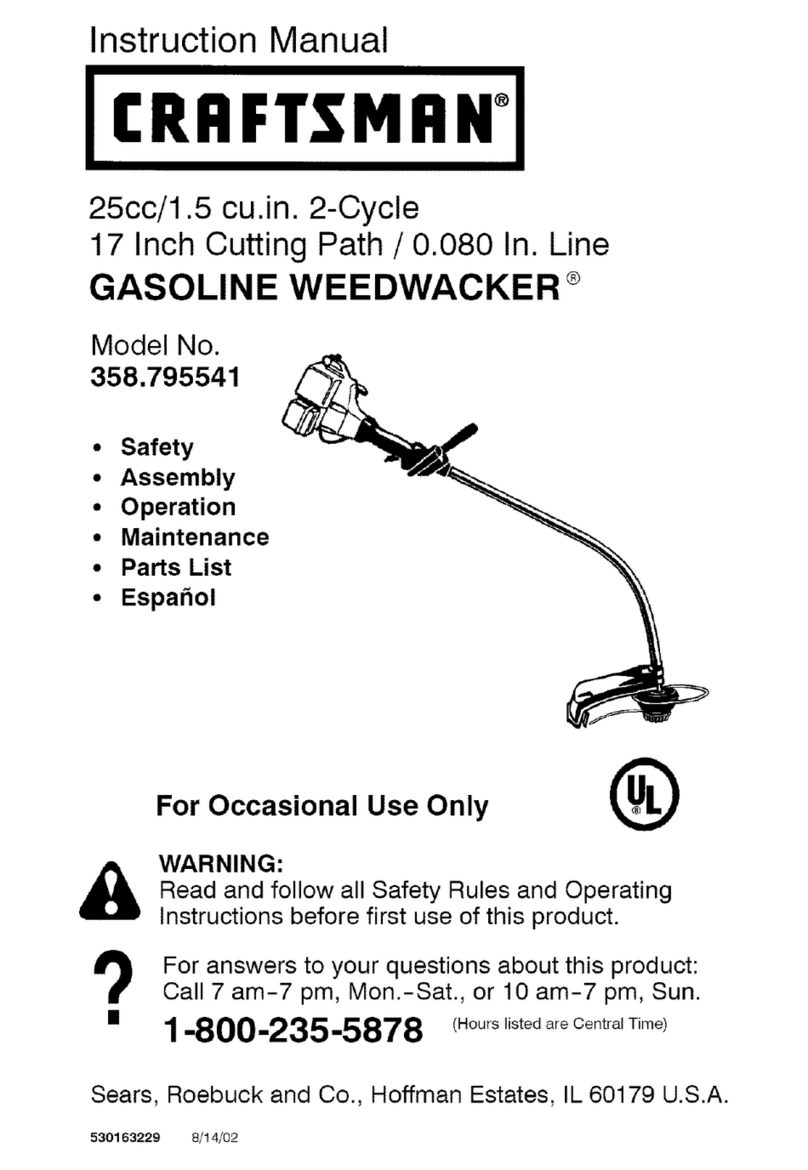
Craftsman
Craftsman WEEDWACKER 358.795541 instruction manual

Flymo
Flymo Mighti-Trim Li FLY047 operating instructions
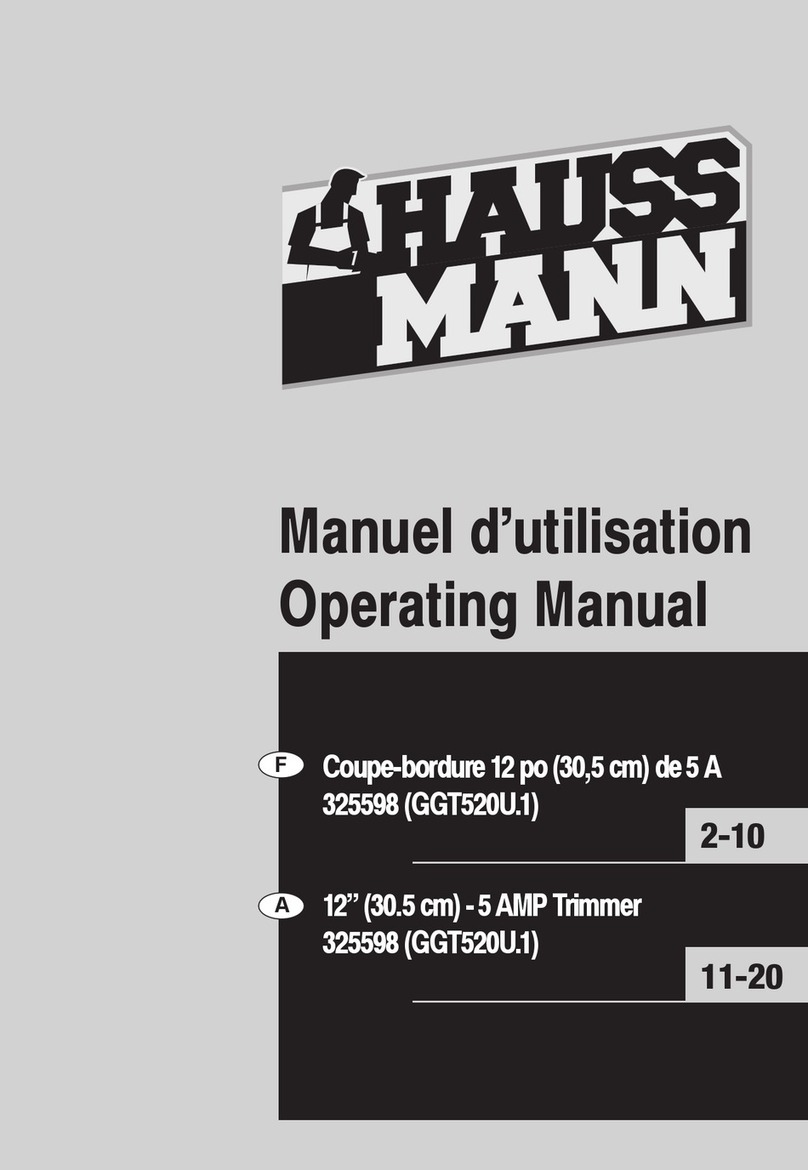
Haussmann
Haussmann GGT520U.1 operating manual

Black & Decker
Black & Decker NST2036 instruction manual
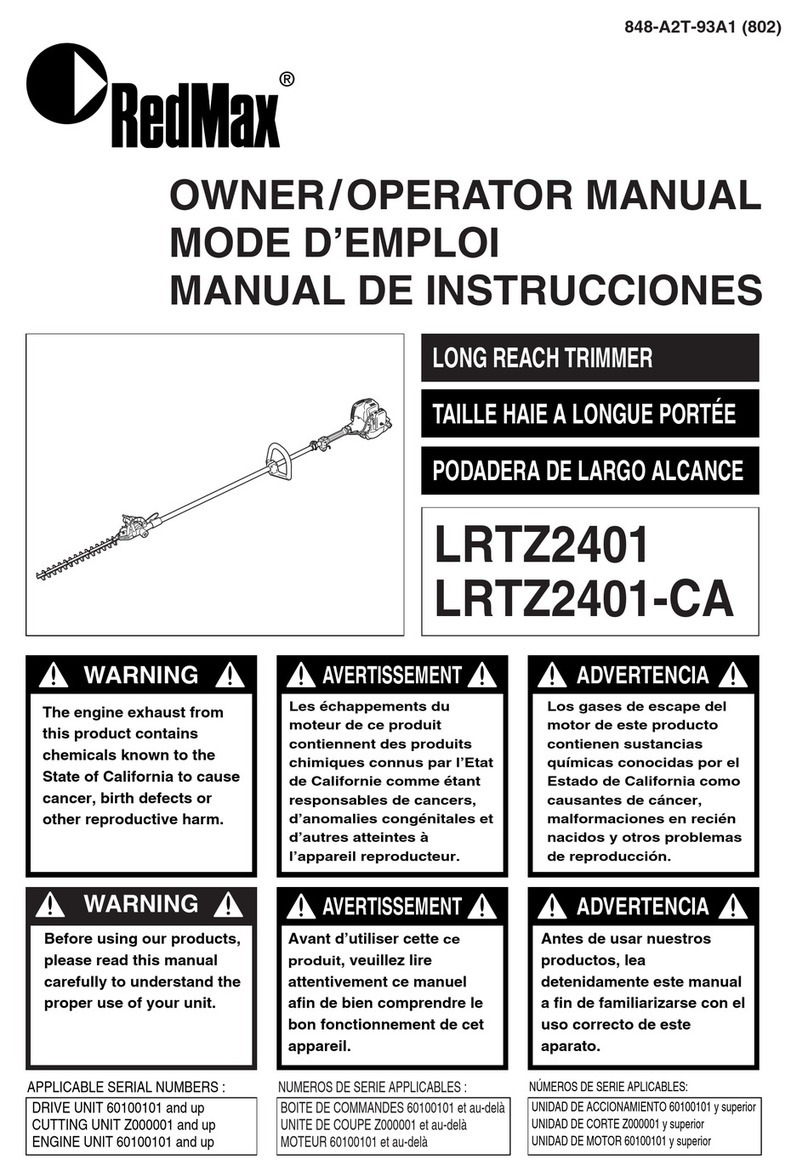
RedMax
RedMax LRTZ2401-CA Owner's/operator's manual
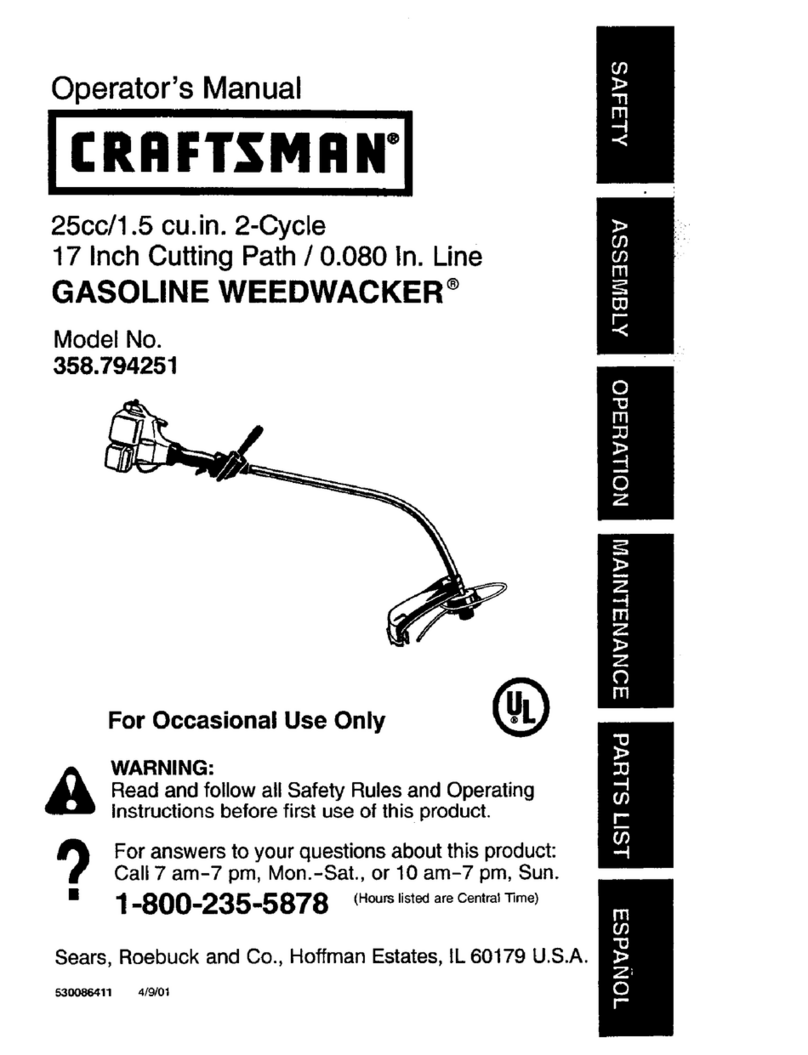
Craftsman
Craftsman WEEDWACKER 358.794251 Operator's manual

Surtek
Surtek DG725 User manual and warranty

Briggs & Stratton
Briggs & Stratton Victa Assembly and owner's manual

Black & Decker
Black & Decker LST522 instruction manual
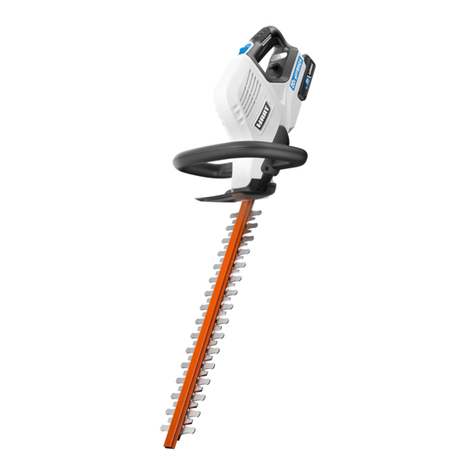
HART
HART HGHHT01 Operator's manual

Black & Decker
Black & Decker GL310 Original instructions
